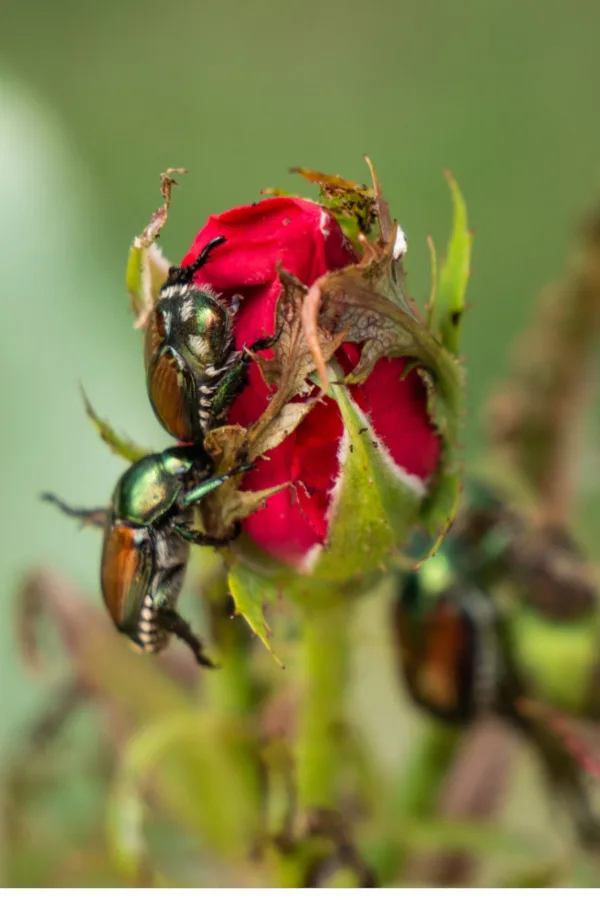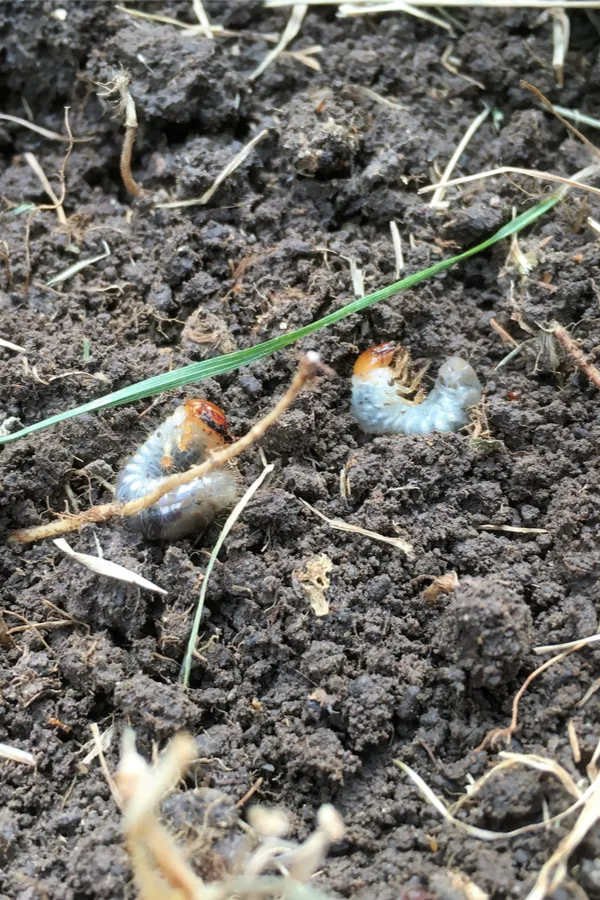When it comes to stopping Japanese beetles from devouring our flowers, shrubs and bushes all over the farm – we always turn to our all natural homemade Japanese beetle spray. Not only is it easy and inexpensive to make, it also happens to be extremely effective!
Unfortunately, if you are not ready for the onslaught of beetles, they can decimate your plants in the blink of an eye. Even worse, when left unchecked, they can easily triple their population with each passing year.
Here in Ohio, Japanese beetles usually begin to appear near the end of June. What starts out as just a few beetles here and there on plants can suddenly turn into hundreds and hundreds attacking your plants – all within just a few days.
Japanese beetles love roses, grape vines, and a long list of shrubs, annuals and perennials. And if you are not ready for them, they can all but destroy the foliage and blooms of your plants.
But there is some good news in the fight – by simply using a two prong approach – you can not only stop the damage to your plants, but also severely drop the population of beetles for future years.
Being Proactive – How To Make Homemade Japanese Beetle Spray
Japanese beetle grubs overwinter and live in the soil. When the beetles come out and feed on your plants, their main purpose is to reproduce. After which, the females lay eggs back into the soil. Those eggs then hatch in late summer to become grubs.
Unfortunately, the more beetles you allow this year to live, mate and deposit eggs in the soil – the more grubs and eventual beetles you will have next year. But by taking care of them now, you can stop the cycle. And when you do, it really does nearly eliminate the issue.
For us, we have been using the two prong approach below for going on 10+ years – and to be honest, although we still stay up with keeping an eye out for them and spraying to protect the plants – we haven’t had much of a population of beetles for the last seven to eight of those years!

Homemade Japanese Beetle Spray – The Perfect All Natural Spray To Stop Beetles!
For us, we approach keeping our plants safe from Japanese beetles with two simple solutions. The first is to simply hand pick beetles off of plants as they arrive. The second is to also use our homemade beetle spray to keep the most vulnerable plants protected.
You would be amazed how quickly hand picking can reduce the beetle population. Heading out in the late morning and brushing them into a bucket of soapy water results in less beetles to mate, and to lay more eggs to become grubs. A few weeks of daily hand picking can and does work!
But to protect our plants in between, we use a secondary approach of an all natural repellent spray made from cedar oil. Together, over time, the two methods have worked wonders to control Japanese beetles for us.
The recipe is easy to follow and the spray is easy to make. Even better, it really does work incredibly well to flush them from plants – and keep them from coming back!

All Natural Japanese Beetle Spray Recipe
Ceder oil is effective as a repellent against Japanese beetles. It will not kill the beetles, but they certainly do not like it in the least. In fact, when it is sprayed when they are on a plant, they leave fast. And if it’s already on the plant – they will stay away, protecting the foliage in the process.
You can make homemade cedar oil spray using a couple of different methods. If you happen to have access to a few eastern cedar boards, you can make the spray simply by soaking the boards in water. But by far the easiest method is to use pure Eastern cedar oil mixed with water.
Making Cedar Spray With Cedar Oil – How To Make Homemade Japanese Beetle Spray
We make our spray with Eastern Cedar oil. Although it tends to be a little bit more expensive than making it with boards, it is certainly a little faster and easier to make. Affiliate Product Link: Essential Eastern Red Cedar Wood Oil – Fox Creek Cedar Oil
For creating spray mix with oil, use 1.5 tablespoons of cedar oil for every 1 gallon of water. Since the oil is already in its purest form, there is no need to heat the water. Just mix thoroughly and you are ready to spray.

Making Cedar Spray With Boards – How To Make Homemade Japanese Beetle Spray
To make your spray using Eastern Red Cedar wood, you will need six to eight small pieces (approx. 4″ long x 2″ wide) of wood. The real key is to keep the chunks of wood small enough to fit down into a 5 gallon bucket.
Place the chunks down into an empty 5 gallon bucket. Next, fill the bucket with hot water. The hot water will help to release the oils in the cedar. Let the boards sit and soak for three to four days. To keep the cedar wood from floating to the top, place a brick or heavy item on top. Stir the bucket a few times each day to help release more oil.
After the boards have had time to soak, pull out the boards and strain the water to remove any loose particles. Your homemade cedar spray is now ready to use!
How To Spray To Control Beetles – How To Make Homemade Japanese Beetle Spray
The best way to apply the spray mix is with a pump sprayer. For smaller areas you can use a spray bottle. Before spraying, add in a few drops of olive oil or mild liquid dish soap to the solution. This will help the spray stick to the foliage and give better results.
Apply the spray liberally to the leaves of any plants the beetles like to attack. If the beetles happen to be on the plant, it will have them quickly leaving. As the mix dries on the foliage, the scent will also keep future beetles from landing on the plants as well.

You will need to reapply the spray often to keep its effectiveness – especially after any rain or heavy morning dew. We usually spray plants every two to three days for the few weeks the beetles are most active.
An All Natural Approach – How To Make Homemade Japanese Beetle Spray
So why not just reach for an insecticide? Not just because of safety or potential health hazards from commercial products, but also because spraying insecticides can actually create even more pest problems for our plants, trees and bushes down the road.
Although insecticides can be effective in killing off beetles, we simply don’t want chemicals touching anything that we will ever eat – period. But beyond that, they simply cause more harm than good.
Insecticides are non-discriminatory. That means they also kill off a huge population of beneficial bugs and pollinators while killing off the beetles. And when there are less bees and butterflies flying around, that means few chances to pollinate your flowers and vegetable plants.
In addition, when a large portion of insects disappear, the normal balance of nature can be completely altered. The result can be a whole new slew problems from insects that were being kept in check by all of those beneficial insects that have been wiped out.
Here is to protecting your plants from Japanese Beetles this year with homemade spray and a little hand picking! Happy Gardening, Jim and Mary.
Old World Garden
Jim and Mary Competti have been writing gardening, DIY and recipe articles and books for over 15 years from their 46 acre Ohio farm. The two are frequent speakers on all things gardening and love to travel in their spare time.
As always, feel free to email us at thefarm@owgarden.com with comments, questions, or to simply say hello! You can sign up for our free email list in the subscribe now box in the middle of this article. Follow us on Facebook here : OWG Facebook. This article may contain affiliate links.

